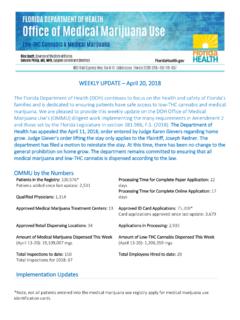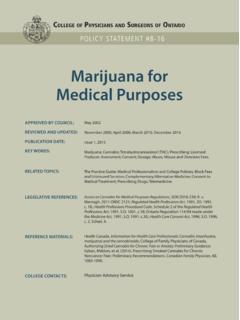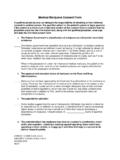Transcription of MEDICAL MARIJUANA ACCESS IN THE UNITED …
1 MEDICAL . MARIJUANA . ACCESS IN THE. UNITED STATES. A PATIENT-FOCUSED. ANALYSIS OF THE. PATCHWORK OF. STATE LAWS. 2018 Annual Report prepared by Americans for Safe ACCESS MEDICAL . MARIJUANA . ACCESS IN THE. UNITED STATES. A PATIENT-FOCUSED. ANALYSIS OF THE. PATCHWORK OF. STATE LAWS. 2018 Annual Report prepared by Americans for Safe ACCESS MEDICAL Cannabis By The PREFACE: THE STATE OF THE MEDICAL Cannabis Qualifying Conditions For State MEDICAL Cannabis The MEDICAL Use Of State-By-State How States Were CATEGORY 1: PATIENT RIGHTS AND CIVIL. PROTECTIONS FROM Arrest Affirmative Parental Rights DUI Employment Explicit Privacy Housing Does Not Create New Criminal Penalties for Organ CATEGORY 2: ACCESS TO Allows Distribution Noncommercial Explicit Right to Edibles/Concentrates/Other Does Not Impose Limits or Bans on Does Not Impose Limits or Bans on Local CATEGORY 3: EASE OF Comprehensive Qualifying Adding New Reasonable ACCESS for Minors.
2 33. Reasonable Caregiver Background Check Number of Patient/Practitioner-Focused Task Force or Advisory Reasonable Fees for Patients & Allows Multiple-Year Reasonable Physician Does Not Classify Cannabis as a Medicine of Last 2. CATEGORY 4: FUNCTIONALITY.. 36. Patients Able to ACCESS Medicine at Dispensaries or Via Cultivation.. 37. No Significant Administrative or Supply Problems.. 37. Patients Can Receive Legal Protections Within a Reasonable Time After Receiving Recommendation.. 37. Reasonable Possession Limit.. 37. Reasonable Purchase Limits.. 38. Allows Patients to Medicate Where They Choose.
3 38. Covered by Insurance or State Health Programs.. 38. Financial Hardship (Fee Waivers/Discount Medicine).. 38. CATEGORY 5: CONSUMER SAFETY. AND PROVIDER REQUIREMENTS.. 40. Dispensaries.. 41. Staff Training.. 41. Standard Operating Procedures and Protocols.. 41. Recall Protocol and Adverse Event Reporting.. 42. Product Labeling.. 42. Required Testing.. 43. Grow/Cultivation.. 43. Staff Training.. 43. Standard Operating Procedures and Protocols.. 43. Pesticide Guidance and Protocols.. 46. Required Testing.. 46. Recall Protocol and Adverse Event Reporting.
4 46. Manufacturing.. 46. Staff Training.. 46. Standard Operating Procedures and Protocols.. 47. Product Labeling.. 49. Required Testing.. 49. Recall Protocol and Adverse Event Reporting.. 50. Laboratory Operations.. 50. Staff Training.. 50. Method Validation in Accordance With AHP Guidelines.. 50. Result Reporting.. 51. Independent or Third Party.. 51. Standard Operating Procedures and Protocols.. 51. State MEDICAL Cannabis Program Regulations And Oversight.. 54. STATE REPORT CARDS.. 56. CONCLUSION.. 156. Grade Comparison APPENDIX 1: MODEL LEGISLATION.
5 162. APPENDIX 2: RECOMMENDATION TO. REGULATORS.. 182. 3. MEDICAL CANNABIS. MARIJUANAINACCESS. AMERICA. IN THE UNITED STATES. MEDICAL CANNABIS. BY THE NUMBERS. 0. 46. States with MEDICAL Deaths Caused by Cannabis Cannabis Laws 2 MIL.+. MEDICAL Cannabis Patients in the $ 500 MIL.+. Federal Tax Dollars Spent on Federal Interference in MEDICAL Cannabis States before Rohrabacher-Farr CJS. Amendment $ 9,000. Clinical Trial Data Using Cannabis for Pain in Patient Years 50+. Qualifying MEDICAL Conditions in MEDICAL Cannabis Programs 4. 25%. Average Drop in Opiate Related Deaths in States with MEDICAL 30,000.
6 Cannabis Laws Studies Published on the Endocannabinoid System 89%. Americans Supporting $ 165 MIL. MEDICAL Cannabis Federal Prescription Drug Cost Savings in MEDICAL Cannabis States in 2013. 66+. Known Cannabinoids 100 MIL. Number of Americans Suffering 128,000. from Chronic Pain Annual Deaths Caused by Prescription Drugs 5. MEDICAL MARIJUANA ACCESS IN THE UNITED STATES. PREFACE: THE STATE OF THE STATES. For over fifteen years, Americans for Safe ACCESS (ASA) has engaged state and federal governments, courts, and regulators to improve the development and implementation of state MEDICAL cannabis laws and regulations.
7 This experience has taught us how to assess whether or not state laws meet the practical needs of patients. It has also provided us with the tools to advocate for programs that will better meet those needs. Passing a MEDICAL cannabis law is only the first step in a lengthy implementation process, and the level of forethought and advance input from patients can make the difference between a well-designed program and one that is seriously flawed. One of THE CURRENT. the most important markers of a well-designed program is whether or not all MEDICAL CANNABIS.
8 Patients who would benefit from MEDICAL cannabis will have safe and legal INDUSTRY IS A. ACCESS to their medicine without fear of losing any of the civil rights and BYPRODUCT OF. protections afforded to them as American citizens. A MOVEMENT. OF DOCTORS, The current MEDICAL cannabis industry is a byproduct of a movement of SCIENTISTS, doctors, scientists, patients, their families, and policymakers advocating PATIENTS, THEIR. to allow patients, under the guidance of a healthcare professional, to use FAMILIES, AND. cannabis therapies. This effort started at the federal level and then, after POLICYMAKERS.
9 Encountering a series of roadblocks, moved to the changing of laws at the ADVOCATING TO. state level in the late 1990s. These early laws anticipated that patients would ALLOW PATIENTS, need to obtain their medicine from a legal market but provided no framework UNDER THE. to make that happen. Laws that regulated the production and distribution GUIDANCE OF. of MEDICAL cannabis were not considered until the early 2000s. By the late A HEALTHCARE. 2000s, state legislators were including production and distribution programs PROFESSIONAL, as a matter of course.
10 TO USE CANNABIS. THERAPIES. The first distribution models were non-profit, member-based collectives, with members supplying their excess cannabis and cannabis products to storefront operations. This model worked with smaller populations of patients, but as the patient population grew, the member-supplied model became more of a legal designation than the actual business model for the majority of distribution centers. In 2010, Colorado was the first state to classify MEDICAL cannabis distribution as a business regulated under the state's Department of Revenue, formally creating the MEDICAL cannabis industry.




